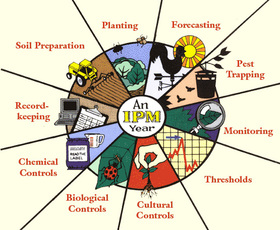IPM (Integrated pest management)

Integrated Pest Management (IPM) is a program of prevention, monitoring, and control which offers the opportunity to eliminate or drastically reduce the use of pesticides, and to minimize the toxicity of and exposure to any products which are used. IPM does this by utilizing a variety of methods and techniques, including cultural, biological and structural strategies to control a multitude of pest problems.
Soil Preparation: Growers give their plants a head start on pest problems by choosing the proper site, testing the soil, rotating crops, creating raised beds where necessary, and providing sufficient organic matter.
Planting: Growers plant crops that tolerate common problems, altering planting time and spacing to discourage certain diseases and insects.
Forecasting: Weather data is consulted to predict if and when pest outbreaks will occur. Treatments can then be properly timed, preventing crop damage and saving sprays.
Pest Trapping: Traps that are attractive to insects are used so that growers can pinpoint when the pest has arrived and decide whether control is justified
Monitoring: Growers inspect representative areas of the fields regularly to determine whether pests are approaching a damaging level.
Thresholds: Before treating, growers wait until pest populations reach a scientifically determined level that could cause economic damage. Until that threshold is reached, the cost of yield and quality loss will be less than the cost for control.
Cultural Controls: The pest's environment it then disrupted by turning under crop residues, sterilizing greenhouse tools, and harvesting early.
Biological Controls: It is necessary for growers to conserve the many beneficial natural enemies already at work. They import and use additional biologicals where effective.
Chemical Controls: Growers select the most effective and appropriate pesticide and properly calibrate sprayers. They then verify that weather conditions will permit good coverage without undue drift.
Recordkeeping: Records of pest traps, weather and treatment are kept for use in pest management decisions
Soil Preparation: Growers give their plants a head start on pest problems by choosing the proper site, testing the soil, rotating crops, creating raised beds where necessary, and providing sufficient organic matter.
Planting: Growers plant crops that tolerate common problems, altering planting time and spacing to discourage certain diseases and insects.
Forecasting: Weather data is consulted to predict if and when pest outbreaks will occur. Treatments can then be properly timed, preventing crop damage and saving sprays.
Pest Trapping: Traps that are attractive to insects are used so that growers can pinpoint when the pest has arrived and decide whether control is justified
Monitoring: Growers inspect representative areas of the fields regularly to determine whether pests are approaching a damaging level.
Thresholds: Before treating, growers wait until pest populations reach a scientifically determined level that could cause economic damage. Until that threshold is reached, the cost of yield and quality loss will be less than the cost for control.
Cultural Controls: The pest's environment it then disrupted by turning under crop residues, sterilizing greenhouse tools, and harvesting early.
Biological Controls: It is necessary for growers to conserve the many beneficial natural enemies already at work. They import and use additional biologicals where effective.
Chemical Controls: Growers select the most effective and appropriate pesticide and properly calibrate sprayers. They then verify that weather conditions will permit good coverage without undue drift.
Recordkeeping: Records of pest traps, weather and treatment are kept for use in pest management decisions